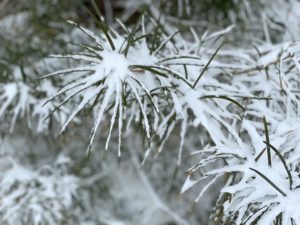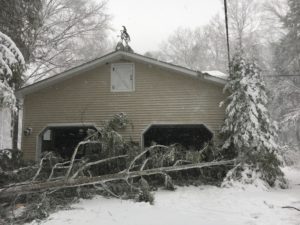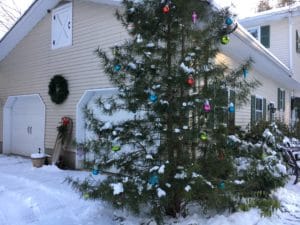Hello fellow readers,
I thought we’d forgo the tradition of decorating one of my favorite evergreen conifers – the Umbrella Pine. It stands above the two-story roof, so it’s not an easy task. Last year half the new lights failed way before Christmas, lessening the enthusiasm to light up the tree this year. But dear Curt got back in the saddle, purchasing a slew of new strings to decorate the tree.

Umbrella Pine Sciadopitys verticillata
Umbrella Pine is a Living Fossil
After an admiral attempt at reiterating the botanical name (Sciadopitys verticillata), he concluded, “It sounds like a dinosaur.” And it is. The Umbrella Pine, also known as the Japanese Umbrella Pine because of its origin, is considered a living fossil. Fossils with the plant date back 230 million years from when dinosaurs walked our world. The way the two-toned dark and light green flat waxy needles whorl around each stem in an umbrella-like fashion even looks prehistoric.
We spoke about another living fossil a few weeks ago, Ginkgo biloba. I wonder if they shared the same root space those millions of years ago. I marvel at the thought. And marvel at how something as soft as trees can survive beyond the strength of dinosaurs.
The word dinosaur comes from the ancient Greek word ‘deinos,’ which means terrible, and ‘sauros,’ lizard or reptile. To think these gentle glorious plants survived the beasts roaming the earth and millions of years beyond them. There’s a lesson in that.

Gratefully our Umbrella Pine was spared when March came In like a Lion.
“The gentle outlasts the strong.”
Verse 36 of the Tao Te Ching states, “The gentle outlasts the strong. The obscure outlasts the obvious.” While the Tao dates back 2500 years, the philosophy of living is relevant today. It’s not a religion; it’s a philosophy to live our true peaceful nature in the rhythm of nature.
It’s fun to imagine Gingko and Umbrella Pines being great friends 230 million years ago. They indeed make a lovely combination in the landscape today.
You may know that trees communicate with each other and need each other to survive just as we do. Peter Wohlleben writes in The Hidden Life of Trees: What They Feel, How They Communicate―Discoveries from a Secret World, “But why are trees social beings? Why do they share food with their species and sometimes nourish their competitors? The reasons are the same for human communities: there are advantages to working together.”
That explains why there are more old trees in forests than those living on their own as stand-alone trees.
 Our dinosaur (Umbrella Pine hardy in zones 5 to 7) sits to the right of the garage giving it protection from winds, as advised by Michael Dirr, the guru of woody plants when planted in zone 5.
Our dinosaur (Umbrella Pine hardy in zones 5 to 7) sits to the right of the garage giving it protection from winds, as advised by Michael Dirr, the guru of woody plants when planted in zone 5.
Umbrella Pine is an uncommon specimen adding to their intrigue.
They can be expensive going in. Our prized tree cost three hundred bucks (wholesale) at five-foot-tall when I planted it 19 years ago, and now tippy tops above the roof line. They say it’s a very slow grower, growing about six inches a year; mine must be speedier than most. She’s also looser in form, which I theorize has to do with being in the afternoon shade. But maybe that’s not the reason.
While acidic soil and full sun are best (6 + hours daily), part sun (3 to 6 hours) can work too. And late afternoon shade is beneficial in hotter zones. I’ve since learned specimens often loosen in form as they grow older (sound familiar?). Branches become “more pendulous and spreading,” writes Dirr.
The neat thing is that the prized plant’s striking reddish-brown exfoliating bark is more visible because of its looseness, making it a perfect tree to decorate. I especially love how the snow coats the branches. It goes to show that aging is beautiful.
Did I mention this living fossil is deer resistant? Maybe that’s why it survived (smile).
Garden Dilemmas? AskMaryStone@gmail.com (and now on your favorite Podcast App.)
There’s more to the story in Episode 87 of the Garden Dilemmas Podcast.
Link to the previous story, Enduring Hope of Ginkgo Trees
Peter Wohlleben’s book The Hidden Life of Trees is featured in Talking to Trees on Arbor Day.


